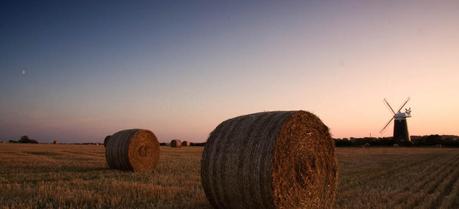 Electricity can be generated using straw bales and straw pellets, a solid biofuel that could be used in the near future. (Credit: Flickr @ Martin Godfrey http://www.flickr.com/photos/springbeanuk/)
Electricity can be generated using straw bales and straw pellets, a solid biofuel that could be used in the near future. (Credit: Flickr @ Martin Godfrey http://www.flickr.com/photos/springbeanuk/)
A recent JRC study, published in GCB Bioenergy (see footnote), shows that electricity from straw-fired plants can achieve 70 to 94% greenhouse gas (GHG) savings, compared both with existing coal plants and with the European electricity mix.
However, GHG emissions are not the only environmental impact of bioenergy, which is why its sustainability should be evaluated on a broader spectrum of impacts.
The article presents a life cycle assessment (LCA) of straw-fired electricity generation (that is electricity generation from burning straw bales and straw pellets, two feedstocks which could become increasingly important as a solid biofuel in the near future). Such a study, which identifies and quantifies several environmental impacts, has been prompted by the debate on setting up sustainability criteria for solid biomass in the EU. The JRC study modeled a number of straw to bioenergy pathways based on data from specific literature and available emissions inventories, focusing on five European countries (Germany, the Netherlands, Spain, the UK and Poland).
As a residue, straw is generally assumed to offer high greenhouse gas (GHG) savings when used for bioenergy. Indeed, agricultural residues are considered to be produced anyway from cultivation of cereals for grain and thus generally no environmental impacts are allocated to them. Furthermore, bioenergy from residues, contrary to biofuels from food crops, is generally deemed not to cause any Indirect land Use Change (ILUC), the increase in cultivated land and its associated GHG emissions due to the diversion of food material for energy use.
The results of the study show that bioenergy produced from straw-fired plants can lead to high GHG savings, but other environmental impacts should also be investigated for a comprehensive evaluation of bioenergy sustainability. Potential impacts of acidification, particulate matter emissions and eutrophication, (the over-increase of vegetation in water bodies caused by an excessive input of nutrients), appear to be higher for bioenergy than the impacts due to the current electricity mix. These impacts should be always kept into account when evaluating bioenergy, especially against other renewable energy sources such as solar and wind.
In addition, the direct and indirect impacts of increased straw removal from agricultural fields on the quality and fertility of the soil should be properly assessed and quantified since they could lead to a decrease in grain yields and consequently to a higher need for more land in production, ultimately causing ILUC. These impacts could thus partly offset and reduce the GHG emissions savings of straw-fired bioelectricity.
Bioenergy is expected to contribute almost 60% of all renewable energy by 2020, which means more than 10% of all energy consumed in the EU, and an even higher percentage is forecast for the period post-2020. Possible sustainability issues deriving from such a massive mobilization of biomass for bioenergy should thus be kept under constant observation.
Giuntoli, J., Boulamanti, A. K., Corrado, S., Motegh, M., Agostini, A. and Baxter, D. (2013). Environmental impacts of future bioenergy pathways: the case of electricity from wheat straw bales and pellets GCB Bioenergy, 5 (5), 497-512 DOI: 10.1111/gcbb.12012
